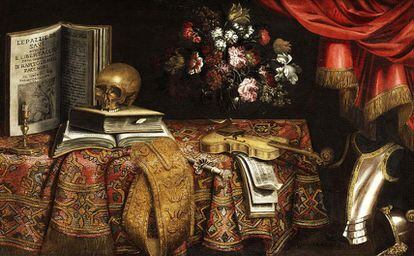Intimidating altarpieces, overwhelming sculptures, paintings, sketches or engravings that invite reflection on one of the ancient topics of human existence.
Although the presence of the finitude of life within the art world has been one of its great constants, by taking multiple discursive or representative forms, the obsession and fascination reflected in the market has reached exorbitant amounts, disproportionate for some.
For their jealous owners?
Something totally justified.
The historical uncertainty and desire to understand the complete cycle of life through images, symbols, plastic expressions, videos, installations or object art has also found its echo and significance within the commercial and financial dynamics, in practically any time, geography and context. , whether for ritual purposes, encomiendas, personal quests or simply as a
witness to each period of human history
and culture that has perceived death as an inevitable presence.
From the
human remains and exhumations seen as museum pieces
, the art to document death during the rise of European Christianity, passing through the peculiarities of mortuary and hunting art, as well as the representation of the horrors of war or the presence almost infinite number of skeletons and skulls in practically any artistic expression.
Death has not been exempt from the gallery, the museum room, the millionaire bid, the acquisition of the obsessive patron and the inclement mercantile fever.
One of the most emblematic and sought-after examples is the painting
Wheat Field by
the Dutch painter Vincent van Gogh, who portrayed the devastation caused by war in a somewhat satirical way.
Completed in July 1890, this painting fetched an estimated value of $35 million.
Bought for 8,200 pounds sterling in 1951, the canvas of the painting entitled Christ of Saint John of the Cross, authored by
Salvador Dalí
, today has more than multiplied its original price, considered invaluable, a world heritage site and a piece protected by the museum. from Scotland.
With the arrival of the first avant-gardes of the 20th century, contemporary art, and the birth of abstract art, the representation of death became freer, more playful, associative, and increasingly removed from its religious, mystical, obscurantist, or even magical halo. or solemn.
Created in 1963 and sold in 2007 for 70.7 million dollars,
Green Car Crash by Andy Warhol
, the main painting in the Death and Disasters series of the most iconic figure in pop art.
One of the most renowned cases for the Mexican context was that of Papalotes Negros, a human skull painted by hand with graphite during a season of Gabriel Orozco's convalescence, it is a piece sold for $27,500 in 2010, joining the prestigious collection of the Museum of Art of Philadelphia.
Although its purchase price is not a millionaire sum like the pieces mentioned above, the acquisition was an exceptional milestone at a regional and generational level for a work of its kind.
In this sense, the most expensive piece of art of this kind is the controversial
For the Love of God, by the British artist Damien Hirst
, being one of the most expensive works currently, both in its preparation and in its commercialization.
The piece features a human skull in a platinum cast, encrusted with 8,601 pure diamonds.
It was sold in 2007 for 90 million, 109,800 dollars.
The work, inspired by an Aztec jade mask that Hirst saw as a boy, is, in the words of its author, the definitive victory of death.
Although it could also be said that it is the triumph of capital and the obsession with death in art.

